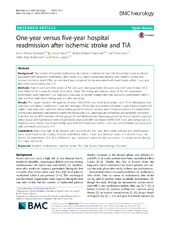| dc.description.abstract | Background: The burden of hospital readmission after stroke is substantial, but little knowledge exists on factors associated with long-term readmission after stroke. In a cohort comprising patients with ischemic stroke and transient ischemic attack (TIA), we examined and compared factors associated with readmission within 1 year and first readmission during year 2–5. Methods: Patients with ischemic stroke or TIA who were discharged alive between July 2007 and October 2012, were followed for 5 years by review of medical charts. The timing and primary cause of the first unplanned readmission were registered. Cox regression was used to identify independent risk factors for readmission within 1 year and first readmission during year 2–5 after discharge. Results: The cohort included 1453 patients, of whom 568 (39.1%) were readmitted within 1 year. Of the 830 patients that were alive and without readmission 1 year after discharge, 439 (52.9%) were readmitted within 5 years. Patients readmitted within 1 year were older, had more severe strokes, poorer functional outcome, and a higher occurrence of complications during index admission than patients readmitted during year 2–5. Cardiovascular comorbidity and secondary preventive treatment did not differ between the two groups of readmitted patients. Higher age, poorer functional outcome, coronary artery disease and hypertension were independently associated with readmission within both 1 year and during year 2–5. Peripheral artery disease was independently associated with readmission within 1 year, and atrial fibrillation was associated with readmission during year 2–5. Conclusions: More than half of all patients who survived the first year after stroke without any readmissions were readmitted within 5 years. Patients readmitted within 1 year and between years 2–5 shared many risk factors for readmission, but they differed in age, functional outcome and occurrence of complications during the index admission. | en_US |

